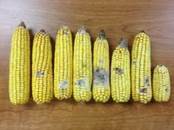Good afternoon,
We had great weather for the kick-off to the Farm-to-Table campaign on Friday with the Hardin County Chamber and Business Alliance. The idea is to take locally grown products and market them in our local restaurants, schools, and grocery stores. The new theme for this Farm-to-Table campaign is “Eat Fresh, Eat Local Hardin County.” There is also a new logo to promote this campaign, and Denny Hensel’s Harvest Pride Tortilla Chips was featured as one of the first agribusinesses in the county by this Local Foods campaign. Denny grows the white corn in the county and the chips are processed in Ada. See the attached news article for more information about this Farm-to-Table marketing initiative.
This Thursday (7/30) will be the Northwest Ohio Field Crops Day at the OARDC branch in Hoytville. The program will begin at 9:00 am and end at 11:30 am. This year’s program has researchers speaking on new corn hybrid technology, proper rates of phosphorus and potassium for optimum corn and soybean production, managing difficult soil-borne diseases in soybeans, and methods to improve soil quality. The program is free and open to the public. Farmers and non-farm individuals may participate to see the research farm and listen to the program. For more information about this agronomy related field day, see the attached article.
Do you have a ram that needs tested? The Union County Sheep Improvement Association in cooperation with the OSU Veterinary Clinic in Marysville is hosting a Ram Fertility Clinic on Sunday, August 16. This Ram Fertility Clinic is being planned to assist sheep producers who have rams that need to be fertility tested prior to breeding season. Rams brought to the OSU Clinic will have a full scale breeding soundness exam (BSE), including a physical examination, semen evaluation, and the owner will be able to discuss breeding options for each ram with Dr. Eric Gordon, OSU Veterinarian, Marysville. Registration is requested by August 7. For more details, see the attached flyer.
This past week there were only two Western Bean Cutworms in the four traps around the county. Hopefully the adult moth flight has peaked in our area, but we still need to be on the lookout for egg masses in corn and damaged ears. The Hardin County Soil and Water Conservation District, Natural Resources Conservation Service, The Nature Conservancy, John Deere, and OSU Extension are teaming up to provide a local field day in Hardin County on September 18. See the attached news release for more information about this event, which is titled ‘Agriculture Conservation, Protecting Water: Keeping Soil and Nutrients in the Field.’ There will be interesting speakers, equipment demonstrations, and even smoking drainage tile, so be sure to put this date on your calendar.
The Manure Science Review is coming up soon on August 12 in Darke County. Field demonstrations include Subsurfer: Poultry litter injector. Incorporating Pelleted Poultry Litter during Application, Composting Manure, Solid Manure Spreader Calibration, Smoking Subsurface Tile Drainage, Reducing Flow through Subsurface Tile Drainage, Applicator Demonstrations, Setbacks, and Cover Crops: Planting and Applying Manure. See the attached flyer for registration and other details.
Upcoming local events include a Garden Seminar tonight (7/28) at 7:00 pm and August 13 at Lovena’s Greenhouse near Upper Sandusky being taught by Hardin County OSU Extension Master Gardeners. See the attached flyer for more information. There will also be a Fairboard meeting on Saturday, August 1 starting at 7:30 pm in the fairgrounds office. Livestock Interviews for 4-H members will be August 4 from 1:00-8:00 pm in the Community Building at the fairgrounds. The Farm Bureau will be meeting that same evening starting at 7:30 pm at Ag Credit. The planned Farm Solar Power Panel Discussion program previously scheduled for August 11 at the Hancock County OSU Extension office has been cancelled. Below I have included some agronomy related articles.
Mark
Good Time to Dig Roots and Inspect for Rootworm Damage – Andy Michel
The good news with all the rain is that it likely caused substantial mortality in corn rootworm larvae. However, growers should still be mindful of our most important corn insect. Over the next few weeks is the time that growers should dig corn roots and inspect them for rootworm feeding. Dig at least 5 plants in 10 different locations in your field. To determine the level of injury, use the Node Injury Scale—this scale ranges from 1 to 3, were 0.5 is half of a node of roots damaged, 1 is a full node of roots damaged, 2 is 2 full nodes damage, etc. To learn more about inspecting corn for rootworm damage, go to http://corn.osu.edu/newsletters/2015/2015-20/good-time-to-dig-roots-and-inspect-for-rootworm-damage.
Ohio Long-Term Phosphorus and Potassium Fertilizer Trials: Grain Yields – Steve Culman, Ed Lentz , Anthony Fulford, Clay Dygert,
Ohio corn, soybean and wheat check-off dollars are currently funding Ohio State Extension research to update the Tri-State Fertilizer Recommendations for Corn, Soybeans, Wheat and Alfalfa (http://ohioline.osu.edu/e2567/index.html). As part of this effort, this is the first of several articles on the results of a nine-year corn and soybean trial conducted in Clark, Wayne, and Wood counties. The main goal of the study was to evaluate grain yield response to phosphorus and potassium fertilization. Go to http://corn.osu.edu/newsletters/2015/2015-20/ohio-long-term-phosphorus-and-potassium-fertilizer-trials-grain-yields to find out more regarding the Tri-State Fertilizer Recommendation trials.
More on Fungicides and Tank-Mixing with Insecticides – Pierce Paul, Andy Michel
Northern Corn Leaf Blight Foliar diseases continue to spread up the corn plant in some fields, so, this may be the year to apply a foliar fungicide to minimize losses due to diseases such as Northern Corn Leaf Blight (NCLB) and Gray Leaf Spot (GLS). Both GLS and NCLB may cause yield losses as high as 50% if they become established before silking (R1) and cause substantial damage to the ear leaves and the leaves above the ear before grain fill is complete. The current weather forecast suggests that conditions (wet and humid with moderate to warm temperatures) will continue to favor the spread of GLS and NCLB as fields begin to tassel. So, this would be the time to protect the upper leaves with a fungicide, particularly if your hybrid is susceptible and your field is in an area with a history of foliar disease problems. To finish reading this article, go to http://corn.osu.edu/newsletters/2015/2015-21/more-on-fungicides-and-tank-mixing-with-insecticides.
Late-Season Weed Issues – Are We Having Fun Yet? – Mark Loux
According to our weather guru, there is no close precedent for a summer like this in the last 100 years, and I can’t recall a year with this much mid-season rain in my almost 30 years here. This has obviously caused immense problems with post-emergence herbicide applications. There are many fields with large giant ragweed plants that still require treatment, should field conditions become suitable for traffic again. Even the best herbicide treatments are not likely to completely control all of the large giant ragweed, but they can be at least partially effective. Go to http://corn.osu.edu/newsletters/2015/2015-21-1/late-season-weed-issues-2013-are-we-having-fun-yet to continue reading about late season weed issues.
Supplemental Forage Options for Late Summer to Early Autumn Planting – Mark Sulc
This has obviously been a difficult year for mechanically harvested forages. Not only has it been nearly impossible to harvest dry forage, but reports are becoming more numerous of damaged forage stands due to the excessive rainfall we’ve experienced. This is especially true of alfalfa. Summer regrowth of alfalfa is poor in many fields and many stands are declining, especially where wheel track damage occurred due to the wet soils during harvest operations. Corn silage yields are expected to be lower in many fields. So overall stored forage supply is tight and forage quality of hay crops has been poor for many due to delayed harvest and rained on hay. The need for additional forage supplies this summer is significant for many. To find out more about late summer and early autumn forage options, go to http://corn.osu.edu/newsletters/2015/2015-21-1/supplemental-forage-options-for-late-summer-to-early-autumn-planting.
Mark A. Badertscher
Agriculture and Natural Resources Educator
OSU Extension Hardin County
1021 W. Lima Street, Suite 103, Kenton, OH 43326
419-674-2297 Office





















